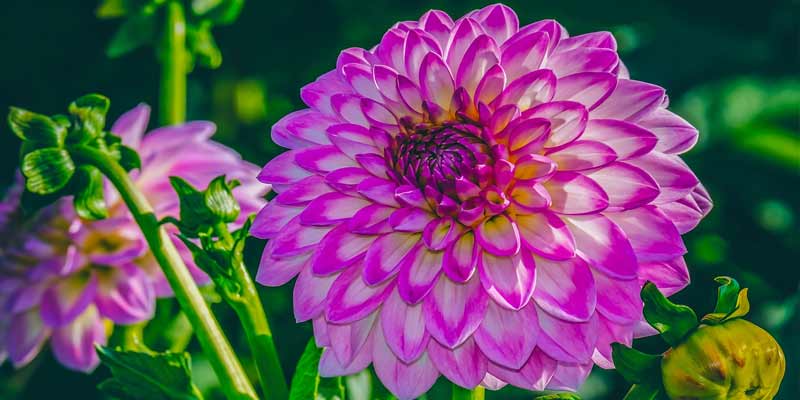Gardeners and flower enthusiasts worldwide cherish dahlias for their captivating blooms, which boast a dazzling array of colors. These versatile flowers enhance the beauty and charm of gardens, landscapes, as well as floral arrangements. Understanding their sunlight requirements remains central to successfully cultivating dahlias.
In this article, we embark on a journey to unravel the mysteries of dahlia sunlight requirements, specifically exploring optimal light conditions for fostering healthy and vibrant dahlias.
Dahlia Sunlight Needs
Plants thrive on sunlight, which energizes photosynthesis and propels growth, blooming, and overall vitality. Like numerous flowering plants, dahlias stipulate particular requirements for sunlight that augment their development and potential to bloom.
It is imperative to comprehend the ideal quantity and quality of sunlight necessary for dahlias; this ensures their peak performance and beauty.
Full Sun Preference
Sun-loving plants such as dahlias thrive in full sunlight. They flourish with a minimum of six to eight hours of direct exposure each day. To promote robust growth, sturdy stems, and abundant blooms, the key factors that elevate their aesthetics, it is essential to plant dahlias in a location receiving ample sunlight.
Morning Sun Exposure
Particularly beneficial for dahlias, the morning sunlight provides them with gentle warmth and illumination – an alternative to the intense heat of the midday sun. When exposed to this light, they experience a drying effect on their foliage’s dew; as a result, risks associated with fungal diseases decrease significantly while promoting healthy plant growth.
Afternoon Shade Tolerance
Dahlias thrive in full sun conditions; however, they exhibit some shade tolerance, particularly during peak heat hours. To counteract potential heat stress and sunburn inherent to regions with scorching afternoon sunlight or high temperatures.
It is advisable to offer dahlias protection through partial shading or filtered sunlight.
Optimal Sunlight Angle
Consider the sunlight’s angle throughout the day when you select a planting location for dahlias. Areas in your garden that face south or west usually receive optimum sunlight, making them ideal for dahlia growth.
However, shun shaded and north-facing spots—these limit exposure to sunlight—and refrain from planting dahlias there.
3 Factors Influencing Dahlia Sunlight Needs
The sunlight requirements of dahlias are influenced by several factors, which shape their growth, flowering, and overall performance in the garden. Gardeners can make informed decisions about optimal dahlia planting locations and methods for superior results, once they understand these influencing factors.
1. Climate and Geographic Location
Significant roles in determining the sunlight needs of dahlias are played by climate and geographic location. Dahlias, throughout their growing season, can thrive under full sun conditions in regions characterized by mild temperatures and abundant sunshine.
However, to prevent heat stress and sunscald in hot, arid climates where intense sunlight is a common occurrence during the afternoon, it becomes necessary to provide them with some shade or protection.
2. Soil Moisture and Drainage
The availability of water and nutrients to dahlia plants hinges on soil moisture and drainage; these factors, in turn, dictate their sunlight requirements.
When the soil is well-drained, allowing for deep water penetration, it prevents both waterlogging and root rot.
Moreover, ensuring adequate soil moisture equips dahlias with resilience against wilting or stress from prolonged sunlight exposure.
3. Planting Location and Microclimates
A planting location’s specific microclimate can indeed influence the volume and intensity of sunlight a dahlia receives. Nearby structures, trees, or other plants may cast shade or dappled sunlight – factors that impact overall exposure to sun for dahlias.
An evaluation of the garden’s microclimate thus plays an integral role in pinpointing optimum locations for planting dahlias.
Tips for Providing Optimal Sunlight to Dahlias
Site Selection
Opt for a dahlia planting location basking in plentiful sunlight, ideally within the south- or west-facing tract of your garden. Verify that this spot allows ample space; it’s crucial to ensure unobstructed growth and blooming potential for your dahlias—neighboring structures or plants should not interfere with this.
Sun Exposure Monitoring
Assess the quality and intensity of sunlight that dahlia plants receive by monitoring their daily exposure. Take note of any seasonal or environmental changes in sunlight patterns, and make necessary adjustments to planting locations or shading.
Protection from Extreme Heat
During periods of extreme heat or intense sunlight, offer dahlias temporary shading or protection; this serves to stave off potential heat stress and sunburn.
To reduce their exposure to scorching temperatures without impeding airflow, employ options such as shade cloth, umbrellas are also an effective choice and lightweight fabric for sunlight diffusion.
Mulching and Soil Moisture Management
To conserve soil moisture, regulate soil temperature, and reduce evaporation, apply a layer of organic mulch around dahlia plants. The application of mulch aids in maintaining optimal soil moisture levels as this enables dahlias to endure prolonged sunlight exposure without desiccation.
Regular Watering
Deeply and consistently water dahlias to guarantee their adequate hydration; this practice will also bolster healthy growth. Optimize root water absorption and minimize evaporative water loss by irrigating the plants in either the early morning or late afternoon, times when evaporation rates are typically lower.
Conclusion
Essential to cultivating healthy, vibrant dahlias that produce an abundance of stunning blooms is understanding their sunlight needs. Gardeners can create optimal growing conditions for dahlias to thrive by providing sufficient sunlight exposure; monitoring environmental conditions such as temperature and humidity levels, and implementing appropriate shading techniques along with meticulous moisture management.
If gardeners provide proper care and attention according to the sunlight requirements, a spectacle of color will be rewarded from these flowers. Beauty that not only brightens your garden but also inspires admiration from every beholder.



Leave a Reply